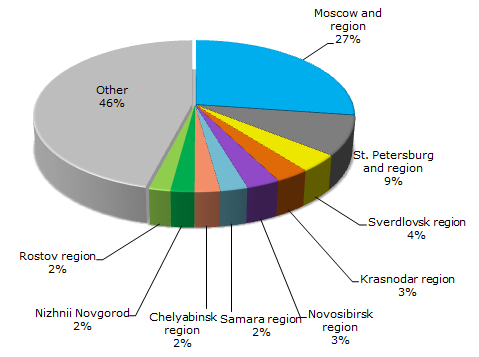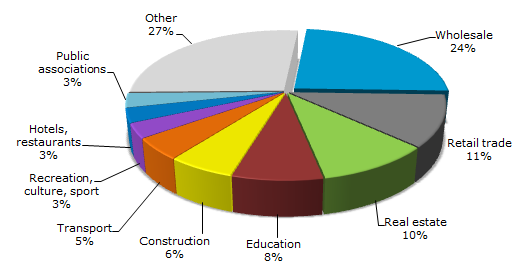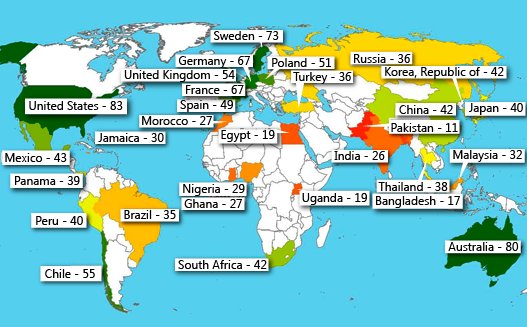Women in business: where it is well to manage for women
According to the data of the Information agency Credinform, there are about 5 mln active legal entities registered in Russia. Representatives of the fair sex hold top director’s post or have ownership interest approximately in 27% of companies.
At the regional level, the most of women in business is concentrated in Moscow and Moscow region (27%), St. Petersburg and Leningrad region (9%), as well as in Sverdlovsk region (4%).

Picture 1. Distribution of women-directors by regions of the RF
In the overwhelming majority of cases ladies are directors of enterprises with the legal form Limited Liability Company (75,6%). Also quite often women are found among the leadership in various budgetary and non-budgetary institutions.
By spheres of activity representatives of the fair sex manage to a greater extent in wholesale and retail trade (24% and 11%, respectively), in the field of real estate operations (9,3%), as well as in the sphere of education (8%).

Picture 2. Distribution of women-directors by fields of activity
A number of women involved in traditionally "male" sectors of the economy such as mining, construction and air transportation is mounting yearly. Excellent examples are such companies as Rosneftegaz OJSC, Irkutskaya neftyanaya kompaniya LLC and AK Transaero OJSC.
The way of many women in business can serve as an excellent example not only for other ladies, but also for representatives of the stronger sex. So, for example, Olga Belyavtseva succeeded in rising through the ranks from an Economist at the factory for production of beverages Lebedyansky OJSC to a Member of the Board of directors and co-owner of Progress Capital OJSC engaged in manufacture of baby food and mineral water (TM FrutoNyanya, TM Lipetsky byuvet). According to estimates of the experts of the company Credinform, the share of factory’s products makes 34,3% of the total volume of the Russian baby food market in physical terms.
The example of Natalya Kasperskaya is also interesting. In 1997, together with her husband, she founded the largest Russian company, specializing in the development of protection systems from viruses and spam - Laboratoriya Kasperskogo CJSC. Since 2003 Natalya Kasperskaya is the General director of the Group of companies InfoWatch involved in software development for protection against information leaks.
An excellent example of successful management of traditionally "male" enterprise is the personality of Guzelia Safina. Guzelia Muharyamovna is the Deputy General Director of Taif OJSC, a major domestic holding, that controls about 96% of chemical, petrochemical and oil and gas industries of Tatarstan.
To open their business women need the same documents as men. However, ladies worldwide encounter various obstacles, both formal and informal.
According to «Global ranking of gender entrepreneurship and development», prepared in 2014 by Global Entrepreneurship Development Institute (GEDI) together with the company Dell, the most comfortable countries for the development of women's business are the United States, Australia and Sweden. At the same time 75% of countries, participating in investigation, do not meet even the basic requirements for successful development. Unfortunately, Russia is included - it shares the 18th line of the rating with Turkey. According to the experts, the key problem is women's limited access to external borrowings. Around the world it is much complicated for women-entrepreneurs to get a credit, than for men. And in Turkey the problem is some more serious: 50% of women have no opportunity to open a bank account. The situation in countries of Africa and Asia is worse, they are placed at the bottom of the rating: Malaysia, Jamaica, Nigeria, Morocco, Ghana, India, Uganda, Egypt, Bangladesh and Pakistan.

Source: Investigation of GEDI Institute (in 2014, together with the company Dell).
Picture 3. Map of the Global ranking of entrepreneurship and development
Explanation to the diagram: countries on the map are painted in different colors according to the place in the ranking. Thus, dark green color corresponds to a high level of scoring estimate, i.e. the business climate for women is most favorable. Yellow – to an average level, dark orange and red – to the lowest level.
It’s interesting that by bad infrastructure the developing countries show amazingly high figures on the number of companies, which are managed by women. Thus, in Ghana 121 women are accounted for by every hundred men-entrepreneurs, and in African countries 69% of startups are representatives of the fair sex. The experts explain such phenomena by that the developing countries use much more active the every opportunity to stimulate the economic growth.
Completing the pre-holiday release, as a departure from the traditional analytics, we’ll provide interesting statistics. The most frequent names of women leaders in Russia are Elena, Tatyana, Natalya, Olga and Irina, and of men - Aleksandr, Sergey, Vladimir, Andrey and Aleksey. It’s interesting that in Moscow and St. Petersburg most of women leaders are named Elena and the most part of men leaders are with the name Aleksandr. Data source: Information and analytical system Globas-i®.
The Information agency Credinform congratulates beautiful ladies with the International Women's Day and wish all of them the prosperity of business and career, family well-being and success in all undertakings.
For whom occupational standards are?
The amendments concerning the mandatory occupational standards, which are preparing to the Labour code, won’t forbid operating not at occupational work. However the demands to employees by education level, years of experience and set of basic skills will be standardized.
To employers it will be offered to apply new standards while developing human resource administration plans, which define the requirements to a specific position, and also while drawing up the employment agreements, manning table and tariffing of labour remuneration.
Such innovations will affect not on all fields of activity. It is supposed that since the 1st January 2016 the mandatory occupational standards will be extended on civil servants and employees of companies, in authorized capital of which the share of government is more than 50%. However by 2020 the innovations will be applied to employees of the rest of companies.
Thus, the panic concerning the closest dismissal of employees, the qualification certificates of which are not correspond to a position held, is premature. According to chairman of the Committee on labor, social policy and veterans affairs Olga Batalina, the main aim of the mandatory occupational standards is to show the requirements, to which you should be ready if you plan to work within a particular specialty. Actually the occupational standards should replace the qualifying references, which are out of date for today as the number of qualifications on the employment market for the last years has significantly increased.
At the same time there are no guarantees that the law will not be improved in the nearest future and the employees of different age and qualifications will not be obligated to confirm its specialty by regulatory experts certification. Today discussions regarding the introduction of a professional examination for qualification confirmation are held among experts. To achieve this aim, a network of independent certification centers can be constructed. The grade, which is obtained in such center, will serve as a special passport of professional viability of the job applicant.
Introduction of professional standards is not Russian know-how. Since the early nineties the development, improvement and implement of occupational standards is a worldwide practice. While developing of own standards, the most countries are guided by the experience of Great Britain, where the quality assurance system of workforce has branched structure, in which occupational standards are just one of the elements. The system also includes: the network of Councils for development of industrial qualifications, the councils define and predict the key skills and knowledge needed for country's economy; professional education and training programs; qualification board, which consists of 6 levels and combines all possible ways of education and vocational preparation, and others.
In Australia the similar document is called – Educational Units. This is the number of approved standards, which allow to estimate the employee’s qualification. As against the British standards, Australian standards describe necessary professional skills and knowledge. However the process of education and keeping it at the proper level is not regulated.
One of the oldest and effective projects of occupational standards is active in Canada within almost more than a half of century and is called Red Seal. It gives the employment opportunities in any region of Canada regardless of the place where the qualification was received and also promotes the mobility of workers. In order to receive the Red Seal you must pass the special exam, the content of which is based on specially created professional standards. Today this experience is the most interesting for Russian experts as the way of further development of professional standardization program.